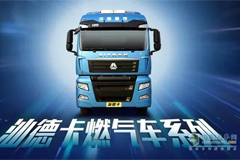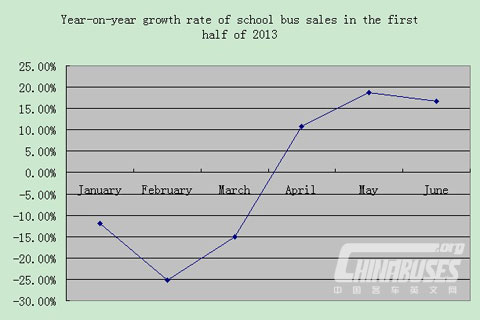Additionally, methane content of natural gas is over 90%. Prior to liquefaction, it is pre-processed, which made impurity such as water and sulfide eliminated completely. The conditioning of natural gas burning is quite easy and convenient. As for LNG in the same unit mass, its calorific value is higher, quality is steadier and burning is more complete. What’s more, it produces no black smoke and can be up to emission standard. Some expert pointed out that once in processing, emission of burning LNG can exceed Euro V and be up to Euro VI standard. Natural gas is cleaner in nature, for that nitric oxide, hydrocarbon and PM in it is little. Without any catalyst, burning natural gas can be qualified with National III and National IV standard.
Therefore, striving to develop LNG bus has become the consensus of the society.
I. Sales analysis of LNG bus from Jan. to Jun. of 2013
Our domestic gas bus application range is mainly in the provinces and cities of three major gas areas in the middle and the west with early development of gas resources and abundant storage of resources, as well as economically developed regions of developed transport. By June of 2013, LNG markets include mainly Beijing, Shanghai, Chongqing, Tianjin, Sichuan Province, Hainan Province, Harbin, Changchun, Xi’an, Urumchi, Guangzhou, Yinchuan, Jinan, Qingdao, Langfang, Puyang, Nanjing, Yangzhou and Taizhou, which are also the key regions of clean automobile.
1. LNG sales analysis of the first half by month (6m or above)
Monthly Sales Chart of LNG Bus from January to June
| Month | Jan. | Feb. | Mar. | Apr. | May | Jun. | In Total |
| Jan.-Jun. of 2013 | 671 | 460 | 554 | 578 | 582 | 573 | 3,418 |
| Jan.-Jun. of 2012 | 267 | 276 | 456 | 333 | 388 | 37 | 2,098 |
| Year-on-year growth | 151.3% | 66.7% | 21.49% | 73.6% | 50.0% | 51.6% | 62.9% |
From the chart above we can see that growth rate of January is the maximum and March is the minimum. All these positive growths show that despite its small sales volume the development of LNG bus is powerful.
2. LNG sales analysis of the first half by length
Sales Chart of LNG Bus from January to June by Length
| Range | 11-12m | 10-11m | 9-10m | 8-9m | 7-8m | 6-7m | In Total |
| Sales volume | 1,099 | 679 | 331 | 448 | 379 | 482 | 3,418 |
| Proportion % | 32.15 | 19.87 | 9.7 |
13.1 |
11.1 | 14.1 | 100 |
From the chart above we can see that sales volume of 11-12m LNG buses is 1,099, taking up nearly a third of the whole sales. What comes next is 11-10m, taking up almost 20% with the sales volume of 679. Then 6-7m ones have a sales volume of 482, taking up nearly 14%。 As a result, 11-12m bus is the majority of LNG sales in the first six months.
3. LNG sales structure analysis of the first half by purposes in the recent 3 years
Transit bus is the absolute subject followed by road buses. Over 83% are transit buses with a slight decreasing trend. And less than 9% are road buses with increasing trend. Group bus always takes up below 5% but with a sign of rising.
Percentage Statistics of LNG Bus in recent Three Years by Purpose
| Purpose | Transit Bus | Road Bus (including travel bus) | Group Bus | School Bus | Other | In Total |
| Sales volume (unit) | 2,859 | 304 | 170 | 57 | 28 | 3,418 |
| Proportion of Jan.-Jun of 2013 % | 83.66 | 8.90 | 4.97 | 1.67 | 0.82 | 100 |
| Proportion of Jan.-Jun of 2012 % | 83.78 | 8.44 | 4.79 | 1.61 | 1.38 | 100 |
| Proportion of Jan.-Jun of 2011 % | 83.22 | 6.55 | 3.51 | 1.33 | 5.39 | 100 |
From the chart above we can see that:
A. In the first half of 2013, transit bus is taking up 83.66% market share, road bus is 8.9%, group bus is 4.97% and school bus is 1.67%. Thus, in the structure of LNG sales in the first half of 2013, transit bus is the subject undoubtedly.
B. Transit bus is the absolute subject followed by road buses. Over 83% are transit buses with a slight decreasing trend. And less than 9% are road buses with increasing trend. Group bus always takes up below 5% but with a sign of rising.
Analysis above indicates that in recent years LNG bus is developing fast and has gradually permeated into other market segment such as road, travel and group.
II. Advantage and disadvantage analysis of LNG bus in operation
1. Drive range has become the biggest advantage of LNG bus
Based on CNG, natural gas bus is mainly applied to taxi and transit bus since it is limited by short drive range. However, the most obvious advantage of LNG road bus is its long drive range which makes its application range and scale much wider. In China, gas transit bus takes up almost 20% of its application in the whole transit bus types. Especially in the west and some cities of the South, gas transit bus has become the mainstream. Up to now, LNG Heat also comes into long-distance passenger transport industry. Equipped with two gas cylinders, drive range of LNG bus can be over 1,000km with only 3 to 5 minutes for gas fulfilling. What’s more, key technology of LNG bus in transport, storage and vehicle application has its own breakthrough which can satisfy demanding and requirements of urban passenger transport.
The breakthrough of LNG in the transport of long distance increases its demanding gradually. It is learned that LNG bus in some passenger transport companies takes up 40%, which even can be extended to 80% as their goal. The hot market pushes LNG bus market to be better. In addition, support and promotion by government departments are the continuous power for LNG bus development as well. It is said that the first special fund for energy conservation and emission reduction is of natural gas bus, which greatly improves positivity of passenger transport enterprises to apply natural gas vehicles. Both the economic and social benefits of LNG bus operation have been into effect, motivating passenger transport enterprises in other places to try LNG road buses. Many enterprises including Shandong Qingdao Jiaoyun Co., Ltd, Jining Jiaoyun Co., Ltd and Fujian Putian Transport all start their own LNG bus plans.
2. Lack of gas stations is the major reason blocking LNG bus market development
At present, there are only about 300 LNG gas stations around China. Lack of gas stations and complicate building procedures are what block LNG vehicle development. Although highway traffic mileage of the most regions in China is long, gas stations covering road net is in lack. All of these problems mentioned above is as a consequence of inspection by multiple departments of government and complicated and slow approval building process. At present, to build a gas station needs to get approval by departments of land, planning, safety supervision, construction, fire-fighting and environmental protection, which is definitely a long and complicated process to be completed for at least one year. Investment of labor, material and expense is huge. Even though all related procedures are completed and gas station is completed, it can be of no inspection and supervision because of no related standard. To avoid responsibilities, relative departments in charge would not launch standard or regulations easily and refuse to complete the inspection of the completed gas stations. Once the accident happens, results are hard to take.
Lack of gas stations influences passenger transport or transit companies a lot. Owing to stable routes of long-distance passenger transport and enhanced LNG drive range, the influence is less. Transit needs to gas up depending a lot on gas stations which is difficult for drivers of transit buses.
Based on research, some LNG buses are often out of filled gas when depending on gas tank to gas up. Recently, because gas tank breaks down and could not come into station, LNG buses of the routes could not gas up, which influenced normal operation. Hence, increasing gas stations construction is a significant measure to promote LNG bus development.











